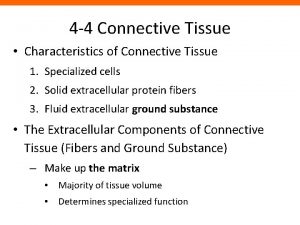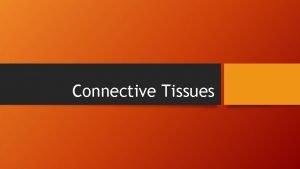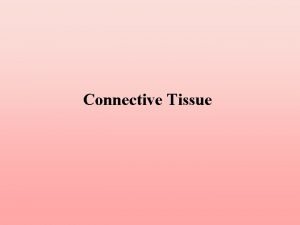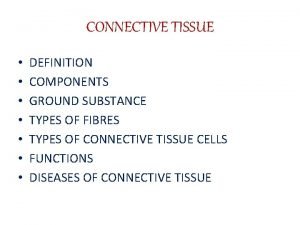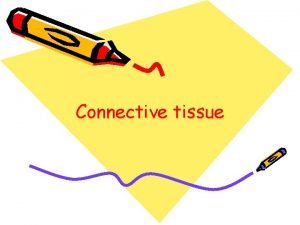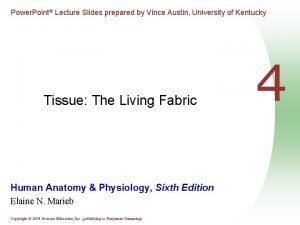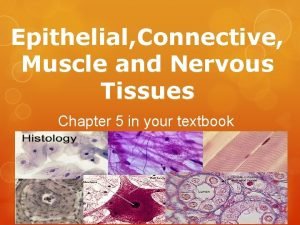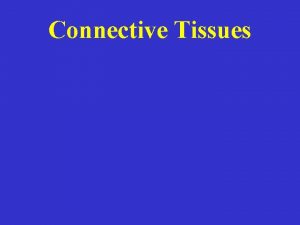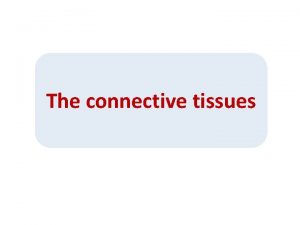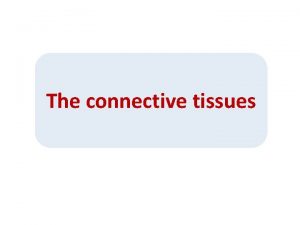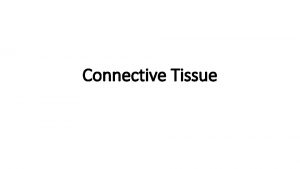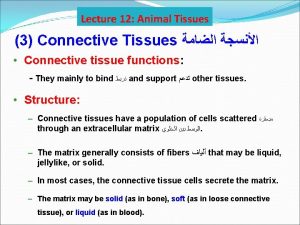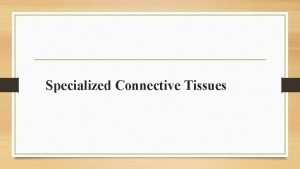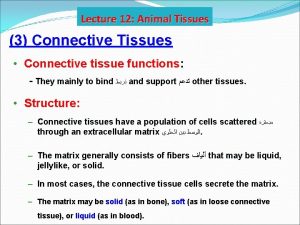2 The connective tissues 1 The connective tissue















- Slides: 15



2 -The connective tissues 1. The connective tissue , connects , holds and supports body tissues and organs together. 2. Connective Tissue is mesodermal in origin. 3. It is characterized by the presence of several types of cells separated and immersed in an abundant intercellular formed by these cells. Function: 1. Structural function ( tendon). 2. Defensive function (phagocytic cells-plasma cells). 3. Neutritional functions due to its rich content of blood vessels and abundant matrix and tissue fluid.

Connective tissue composed of 1 - Matrix • (may be solid (as in bone), soft (as in loose connective tissue), or liquid (as in blood). 2 - Fibers: • A- Collagenous fibers (white) (protein=collagen) (flexible-bundles- unbranched ) • B- elastic fibers (protein=elastin) ( elastic singlebranched) • C- reticular fibers. (protein =reticulin) 3 - Cells • fibroblast and fibrocytes- plasma cell –adipocytesmast cell

Types of connective tissues: 1 --Connective tissue proper: A-Loose connective tissue. B-Adipose connective tissue. C-Dense fibrous connective tissue. 2 -Specialized connective tissue: A-cartilage (perichondrium- chondroblast and chondrocytesmatrix) B-bone (periosteum-osteoblasts-osteocytes)-ossien(calcium phosphates –calcium carbonate) C-Blood (red blood cells-white blood cell-plateletes )and lymph

1 - Connective tissue proper A-Loose Connective tissue Ø - Loose connective tissue has all three fiber types(collagenelastic –reticular). Ø Flexible-richly vascular support epithelial T. Ø It composes of different cell types: 1 -fibroblast (secretes matrix & fibers) 2 -Macrophage (defense by phagocytosis) 3 - adipocyte (storage fat as a source of energy)

B-Adipose connective tissue ØIt is a type of connective tissues that store fat in adipose cell distributed throughout the matrix ØFunction: 1 -Store energy. 2 -Subcutaneous adipose tissue shapes the body. 3 -Act as a fixative to vital organ as kidney and uterus.

C-Dense fibrous connective tissue Ødense collagen fibers-little amount of ground substance –less flexible and more resistant than loose CT. Øexample : tendon

2 -Specialized connective tissue A- cartilage ØWe have cartilage in nose, ears, and vertebral disks (Support )

B- Bone ØThe skeleton supporting most vertebrates is made of bone. ØThe bone contain osteoblasts that deposit a matrix and collagen fibers. ØHard mammalian bones consists of repeating units called osteon (Haversian system). Each osteon has a central canal containing blood vessels and nerves that service the bone.

C-Blood Ø The matrix is a liquid called plasma, consisting of water, salts, and a variety of dissolved proteins. Ø Types of blood cells are: 1. Erythrocytes (red blood cells), 2. Leukocytes (white blood cells) 3. Platelets. Ø Functions of cells: • Red cells carry oxygen. • White cells function in defense against microbes. • Platelets help in blood clotting.

4 -Nervous Tissue • It consists of two types of cells : (a)-Neurons (nerve cells) It consists of cell body and extensions, called dendrites and axon. • The neurons(receive information and conduct it) (b)-Neuroglia (supporting cell ) (b) Neuroglia

• Dendrites transmit nerve impulses from their tips toward the rest of the neuron. • Axons transmit impulses toward another neuron or toward an effector, such as a muscle cell.


 Body tissues chapter 3 cells and tissues
Body tissues chapter 3 cells and tissues Eisonophil
Eisonophil Body tissues chapter 3 cells and tissues
Body tissues chapter 3 cells and tissues Chapter 3 cells and tissues
Chapter 3 cells and tissues Four major tissue types
Four major tissue types Characteristic of connective tissue
Characteristic of connective tissue Connective tissue
Connective tissue What do all connective tissues have in common
What do all connective tissues have in common Specialised connective tissues
Specialised connective tissues Dense connective tissue
Dense connective tissue Connective tissue components
Connective tissue components What type of connective tissue is found in the aorta
What type of connective tissue is found in the aorta Dense connective tissue definition
Dense connective tissue definition Dense irregular connective tissue description
Dense irregular connective tissue description Function of skeletal muscle
Function of skeletal muscle Description of nerve tissue
Description of nerve tissue





